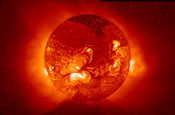|
|
Sun-Earth Connection Continued A Closer Look at Solar Flares
What's been missing in solar science up to now is a way to study the fine details of the very high-energy bursts known as solar flares. Solar flares often erupt off the surface of the sun just before a CME. The largest flares have the energy equivalent of a billion megatons of TNT, making them the biggest known explosions in today's solar system. Until now, scientists haven't had much luck studying the events that trigger solar flares. That's because solar observatories that use visible light images, such as SOHO, don't capture the high-energy releases that immediately precede a visible solar flare.
A diminutive new spacecraft is about to fill that information void. With a launch date of July 2000, the High Energy Solar Spectroscopic Imager (HESSI) will spin in place in the sky above Berkeley, California, its nine solar detectors beaming data back to computers at UC Berkeley's Space Sciences Laboratory. These detectors are specially designed to take images in the high-energy X-ray and gamma-ray portions of the electromagnetic spectrum. HESSI's three-year mission: to capture X-ray and gamma-ray images of tens of thousands of microflares and hundreds of larger flares at very high resolution. With new data from HESSI, scientists can study for the first time the detailed anatomy of solar flares during a time when the sun's activity will be at a maximum. "It's important to observe X-rays," says Christopher Johns-Krull of UC Berkeley's Space Science Lab, "because they show the initial energy release when particles are accelerated on the sun's surface. Knowing these fine details will help us understand the whole process leading up to solar flares."
Armed with this new information, they'll begin to tackle questions about the basic physics of how light photons and other elementary particles get accelerated in the sun's corona to emerge at nearly the speed of light, releasing tremendous amounts of energy in the process. Plasma released from the sun's corona during a solar flare can exceed tens of millions of degrees. With an increased understanding of how CMEs and solar flares originate in the sun, comes the chance that scientists will be able to better predict and prepare for adverse space weather. Along with other solar observatories, including SOHO, and the joint Japanese-U.S. spacecraft Yohkoh, scientists will have the best view yet of the sun going into the next solar maximum period. Says solar scientist Chris Johns-Krull: "We feel like we have the sun covered now." |

|

|

|


